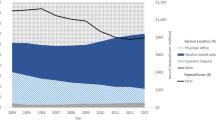Abstract
Purpose
With an aging population, cost containment and improved outcomes will be crucial for a sustainable healthcare ecosystem. Current data demonstrate great variation in payments for procedures and diagnostic workup of benign prostatic hyperplasia (BPH). To help determine the best financial value in BPH care, we sought to analyze the major drivers of total payments in BPH.
Materials and methods
Commercial and Medicare claims from the Truven Health Analytics Markestscan® database for the Austin, Texas Metropolitan Service Area from 2012 to 2014 were queried for encounters with diagnosis and procedural codes related to BPH. Linear regression was utilized to assess factors related to BPH-related payments. Payments were then compared between surgical patients and patients managed with medication alone.
Results
Major drivers of total payments in BPH care were operative, namely transurethral resection of prostate (TURP) [$2778, 95% CI ($2385–$3171), p < 0.001) and photoselective vaporization (PVP) ($3315, 95% CI ($2781–$3849) p < 0.001). Most office procedures were also associated with significantly higher payments, including cystoscopy [$708, 95% CI ($417–$999), p < 0.001], uroflometry [$446, 95% CI ($225–668), p < 0.001], urinalysis [$167, 95% CI ($32–$302), p = 0.02], postvoid residual (PVR) [$245, 95% CI ($83–$407), p < 0.001], and urodynamics [$1251, 95% CI ($405–2097), p < 0.001]. Patients who had surgery had lower payments for their medications compared to patients who had no surgery [$120 (IQR: $0, $550) vs. $532 (IQR: $231, $1852), respectively, p < 0.001].
Conclusion
Surgery and office-based procedures are associated with increased payments for BPH treatment. Although payments for surgery were more in total, surgical patients paid significantly less for BPH medications.

Similar content being viewed by others
Abbreviations
- BPH:
-
Benign prostatic hyperplasia
- TURP:
-
Transurethral removal of the prostate
- PVP:
-
Photoselective vaporization
- PVR:
-
Post-void residual
- PSA:
-
Prostate specific antigen
- MSA:
-
Metropolitan service area
- EVP:
-
Electro vaporization of prostate
References
Lee SWH, Chan EMC, Lai YK (2017) The global burden of lower urinary tract symptoms suggestive of benign prostatic hyperplasia: a systematic review and meta-analysis. Sci Rep 7:7984
Saiga CS, Joyce G (2005) Economic costs of benign prostatic hyperplasia in the private sector. J Urol 173(4):1309–1313
Porter ME (2010) What Is value in health care? NEJM 363(26):2477–2481
Kaye D, Miller D, Ellimoottil C (2017) Alternative payments and urology. Curr Opin Urol 27(4):360–365
Keeler EB (1992) Effects of cost sharing on use of medical services and health. Med Pract Manag 317–321
Koo K, Yap RL (2017) How readable is BPH treatment information on the internet? Assessing barriers to literacy in prostate health. Am J Men’s Health 11(2):300–307
Modi PK, Portney D, Hollenbeck BK (2018) Engaging telehealth to drive value-based urology. Curr Opin Urol 28:342–347
“Urological Care.” Michigan Urological Surgery Improvement Collaborative (MUSIC), musicurology.com/
“Commercial Claims and Encounters Medicare Supplemental.” Truven Health MarketScan®, 2015
Franc BL, Copeland TP (2018) Geographic variation in postoperative imaging for low-risk breast cancer. J Natl Compr Canc Netw 16(7):829–837
Merlo J, Chaix B, Ohlsson H et al (2006) A brief conceptual tutorial of multilevel analysis in social epidemiology: using measures of clustering in multilevel logistic regression to investigate contextual phenomena. J Epidemiol Community Health 60:290–297
Larsen K, Merlo J (2005) Appropriate assessment of neighborhood effects on individual health: integrating random and fixed effects in multilevel logistic regression. Am J Epidemiol 161:81–88
Shah A, Gahan JC, Sorokin I (2018) Comparison of robot-assisted versus open simple prostatectomy for benign prostatic hyperplasia. Curr Urol Rep 19:71
Ulchaker JC, Martinson MS (2017) Cost-effectiveness analysis of six therapies for the treatment of lower urinary tract symptoms due to benign prostatic hyperplasia. Clinicoecon Outcomes Res 29(10):29–34
Bradley GC, James UC (2018) Costs of managing benign prostatic hyperplasia in the office and operating room. Curr Urol Rep 19:72
Kaplan AL, Agarwal N, Setlur NP, Tan HJ, Niedzwiecki D et al (2015) Measuring the cost of care in benign prostatic hyperplasia using time-driven activity-based costing (TDABC). Healthcare 3:43–48
Erman A, Krahn ML, Elterman DS (2018) Pharmacotherapy vs surgery as initial therapy for patients with moderate-to-severe benign prostate hyperplasia: a cost-effectiveness analysis. BJU Int
Foster HE, Barry MJ, Dahm P (2018) Surgical management of lower urinary tract symptoms attributed to benign prostatic hyperplasia: AUA guideline. J Urol 200:612–619
Strope SA (2018) Evidence-based guidelines in lower urinary tract symptoms secondary to benign prostatic hyperplasia and variation in care. Curr Opin Urol 28:262–266
Wei JT, Miner MM, Steers WD (2011) Benign prostatic hyperplasia evaluation and management by urologists and primary care physicians: practice patterns from the observational BPH registry. J Urol 186:971–976
Author information
Authors and Affiliations
Contributions
JW: project development and manuscript writing/editing. VEV: data collection, management, analysis and manuscript writing/editing. JW: manuscript writing/editing. AP: manuscript writing/editing. JSW: Protocol/project development and manuscript editing. ECO: protocol/project development and manuscript editing.
Corresponding author
Ethics declarations
Conflict of interest
The authors declare that they have no competing interests.
Informed consent
Data deidentified.
Additional information
Publisher's Note
Springer Nature remains neutral with regard to jurisdictional claims in published maps and institutional affiliations.
Rights and permissions
About this article
Cite this article
Webb, J.C., Valencia, V.E., Wenzel, J. et al. Value-based care for the treatment and evaluation of benign prostatic hyperplasia: an analysis of a metropolitan service area claims database. World J Urol 38, 3245–3250 (2020). https://doi.org/10.1007/s00345-020-03109-y
Received:
Accepted:
Published:
Issue Date:
DOI: https://doi.org/10.1007/s00345-020-03109-y



